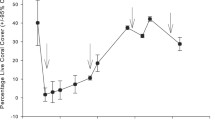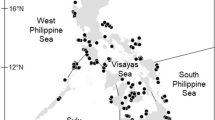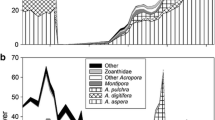Abstract
Elevated sea surface temperatures in the late 1990s were associated with widespread coral mortality in the Arabian Gulf, particularly in Acropora dominated areas. This study investigates the composition, condition, and recruitment patterns of coral communities in Saih Al-Shaib, Dubai, United Arab Emirates, a decade after mass bleaching. Five statistically distinct communities were identified by cluster analysis, with grouping optimized from 17 significant indicator species. Overall, 25 species of scleractinian coral were observed, representing 35 ± 1.6% coral cover. Densities of recruits were low (0.8 ± 0.2 m−2), and composition generally reflected that of the surrounding adult community. Ten years after mass mortality, Acropora dominated assemblages were observed in three of the six sites examined and coral cover (41.9 ± 2.5%) was double post-bleaching cover. One shallow near-shore site appears to have had recovery of Acropora reset by a further bleaching event in 2002. However, the prevalence of young Acropora colonies here indicates that recovery may recur in several years. One area formerly dominated by Acropora is now dominated by faviids and poritids, with adult and juvenile composition suggesting this dominance shift is likely to persist. Porites lutea and Porites harrisoni dominated communities were negligibly impacted by the bleaching events, and the limited change in coral cover and composition in intervening years likely results from slow growth and low recruitment. Despite strong recovery of several dominant Acropora species, five formerly common species from this area were not observed suggesting local extinction. Dubai coral communities exhibit both resistance and resilience to elevated sea temperatures. The conservation of these patch reefs is warranted given the predicted increase in bleaching events, and the role that these communities may play in regional recovery.



Similar content being viewed by others
References
Aronson R, Precht WF, Toscano MA, Koltes KH (2002) The 1998 bleaching event and its aftermath on a coral reef in Belize. Mar Biol 141:435–447
Arthur R, Done TJ, Marsh H (2005) Benthic recovery four years after an El Nino-induced coral mass mortality in the Lakshadweep Atolls. Curr Sci 89:694–699
Arthur R, Done TJ, Marsh H, Harriott V (2006) Local processes strongly influence post-bleaching benthic recovery in the Lakshadweep Islands. Coral Reefs 25:427–440
Ateweberhan M, Bruggemann J, Breeman A (2006) Effects of extreme seasonality on community structure and functional group dynamics of coral reef algae in the southern Red Sea (Eritrea). Coral Reefs 25:391–406
Baird AH, Marshall PA (2002) Mortality, growth and reproduction in scleractinian corals following bleaching on the Great Barrier Reef. Mar Ecol Prog Ser 237:133–141
Bena C, van Woesik R (2004) The impact of two bleaching events on the survival of small coral colonies (Okinawa, Japan). Bull Mar Sci 75:115–125
Bruno J, Siddon C, Witman J, Colin P, Toscano M (2001) El Nino related coral bleaching in Palau, western Caroline Islands. Coral Reefs 20:127–136
Carriquiry J, Cupul-Magana A, Rodriguez-Zaragoza F, Medina-Rosas P (2001) Coral bleaching and mortality in the Mexican Pacific during the 1997–98 El Nino and prediction from a remote sensing approach. Bull Mar Sci 69:237–249
Clode P, Marshall A (2003) Variation in skeletal microstructure of the coral Galaxea fascicularis: effects of an aquarium environment and preparatory techniques. Biol Bull 204:138–145
Coles S (2003) Coral species diversity and environmental factors in the Arabian Gulf and the Gulf of Oman: a comparison to the Indo-Pacific region. Atoll Res Bull 507:1–19
Coles S, Brown B (2003) Coral bleaching—capacity for acclimatization and adaptation. Adv Mar Biol 46:183–223
Coles SL, Fadlallah YH (1991) Reef coral survival and mortality at low-temperatures in the Arabian Gulf—new species-specific lower temperature limits. Coral Reefs 9:231–237
Dodge R (2002) Bleaching in the southern Arabian Gulf NOAA coral reef watch program: NOAA National environmental satellite data and information service, Maryland. Accessed 8-Apr.-2007 from http://coralreefwatch.noaa.gov/satellite/bleachingreports/als_bleaching.9.27.2002
Dufrene M, Legendre P (1997) Species assemblages and indicator species: the need for a flexible asymmetrical approach. Ecol Monogr 67:345–366
EWS-WWF (2006) Coral reef investigations in Abu Dhabi and eastern Qatar: biannual report. Emirates Wildlife Society-World Wildlife Fund, Dubai
Fadlallah YH (1996) Synchronous spawning of Acropora clathrata coral colonies from the western Arabian Gulf (Saudi Arabia). Bull Mar Sci 59:209–216
Flora CJ, Ely PS (2003) Surface growth rings of Porites lutea microatolls accurately track their annual growth. Northwest Sci 77:237–245
George J, John D (1999) High sea temperatures along the coast of Abu Dhabi (UAE), Arabian Gulf—their impact upon corals and macroalgae. Reef Encounter 25:21–23
Hall V, Hughes T (1996) Reproductive strategies of modular organisms: comparative studies of reef-building corals. Ecology 77:950–963
Kohler K, Gill S (2006) Coral Point Count with Excel extensions (CPCe): a Visual Basic program for the determination of coral and substrate coverage using random point count methodology. Comput Geosci 32:1259–1269
Lambo A, Ormond R (2006) Continued post-bleaching decline and changed benthic community of a Kenyan coral reef. Mar Poll Bull 52:1617–1624
Loya Y, Sakai K, Yamazato K, Nakano Y, Sambali H, Van Woesik R (2001) Coral bleaching: the winners and the losers. Ecol Lett 4:122–131
McClanahan T, Maina J, Soede L (2002) Effects of the 1998 coral morality event on Kenyan coral reefs and fisheries. Ambio 31:543–550
McClanahan TR, Maina J, Starger CJ, Herron-Perez P, Dusek E (2005) Detriments to post-bleaching recovery of corals. Coral Reefs 24:230–246
McCune B, Grace J (2002) Analysis of ecological communities. MjM Software Design, Gleneden Beach
McCune B, Mefford M (1999) Multivariate analysis of ecological data (Version 4.14). MjM Software, Gleneden Beach
Mumby P, Chisholm J, Edwards A, Clark C, Roark E, Andrefouet S, Jaubert J (2001) Unprecedented bleaching-induced mortality in Porites spp. at Rangiroa Atoll, French Polynesia. Mar Biol 139:183–189
Obura D (2001) Can differential bleaching and mortality among coral species offer useful indicators for assessment and management of reefs under stress? Bull Mar Sci 69:421–442
Purkis S, Riegl B (2005) Spatial and temporal dynamics of Arabian Gulf coral assemblages quantified from remote-sensing and in situ monitoring data. Mar Ecol Prog Ser 287:99–113
Riegl B (1999) Corals in a non-reef setting in the southern Arabian Gulf (Dubai, UAE): fauna and community structure in response to recurring mass mortality. Coral Reefs 18:63–73
Riegl B (2001) Inhibition of reef framework by frequent disturbance: examples from the Arabian Gulf, South Africa, and the Cayman Islands. Paleo 175:79–101
Riegl B (2002a) Effects of the 1996 and 1998 positive sea-surface temperature anomalies on corals, coral diseases and fish in the Arabian Gulf (Dubai, UAE). Mar Biol 140:29–40
Riegl B (2002b) Phoenix from the Ashes: Repetitive mass mortality and the biogeology of Southern Arabian Gulf (United Arab Emirates) coral systems. In: Bright M, Dworschak P, Stachowitsch M (eds). The Vienna School of Marine Biology: A tribute to Jorg Ott. Facultas Universitatsverlag, Wien, pp 137–159
Sheppard C (2003) Predicted recurrences of mass coral mortality in the Indian Ocean. Nature 425:294–297
Sheppard C, Loughland R (2002) Coral mortality and recovery in response to increasing temperature in the southern Arabian Gulf. Aquat Ecosyst Health Manag 5:395–402
Sheppard C, Obura D (2005) Corals and reefs of Cosmoledo and Aldabra atolls: extent of damage, assemblage shifts and recovery following the severe mortality of 1998. J Nat Hist 39:103–121
Sheppard C, Price A, Roberts C (1992) Marine ecology of the Arabian region: patterns and processes in extreme tropical environments. Academic, Toronto
Smit F, Mocke G, Al-Zahed K (2005) Quantifying and managing the coastal response to major offshore developments in Dubai. Proceedings of the 14th Biennial Coastal Zone Conference New Orleans, Louisiana. NOAA Coastal Services Center, Charleston
Stobart B, Teleki K, Buckley R, Downing N, Callow M (2005) Coral recovery at Aldabra Atoll, Seychelles: five years after the 1998 bleaching event. Philos Trans R Soc Lond 363:251–255
Tabachnick B, Fidell L (2001) Using multivariate statistics. Allyn and Bacon, Needham Heights
Tamelander J (2002) Coral recruitment following a mass mortality event. Ambio 31:551–557
Veron J (2000) Corals of the world. Australian Institute of Marine Science, Townsville
Wellington G, Glynn P, Strong A, Navarette S, Wieters E, Hubbard D (2001) Crisis on coral reefs linked to climate change. Eos 82:1–7
West J, Salm R (2003) Resistance and resilience to coral bleaching: implications for coral reef conservation and management. Cons Biol 17:956–967
Wilkinson C (2004) Status of coral reefs of the world: 2004. Australian Institute of Marine Science, Townsville
Yap HT, Alvarez RM, Custodio HM, Dizon RM (1998) Physiological and ecological aspects of coral transplantation. J Exp Mar Biol Ecol 229:69–84
Zar J (1996) Biostatistical analysis. Prentice Hall, Upper Saddle River
Acknowledgments
Thanks are extended to the Dubai Municipality Marine Sanctuary Unit for providing sampling permits and to Major Ali Saqr Al-Suwaidi of the Emirates Marine Environmental Group for providing the facilities from which this study was conducted. An earlier version of this manuscript has been greatly improved by the critical comments by B. Riegl.
Author information
Authors and Affiliations
Corresponding author
Additional information
Communicated by S.W.A. Naqvi.
Rights and permissions
About this article
Cite this article
Burt, J., Bartholomew, A. & Usseglio, P. Recovery of corals a decade after a bleaching event in Dubai, United Arab Emirates. Mar Biol 154, 27–36 (2008). https://doi.org/10.1007/s00227-007-0892-9
Received:
Accepted:
Published:
Issue Date:
DOI: https://doi.org/10.1007/s00227-007-0892-9




